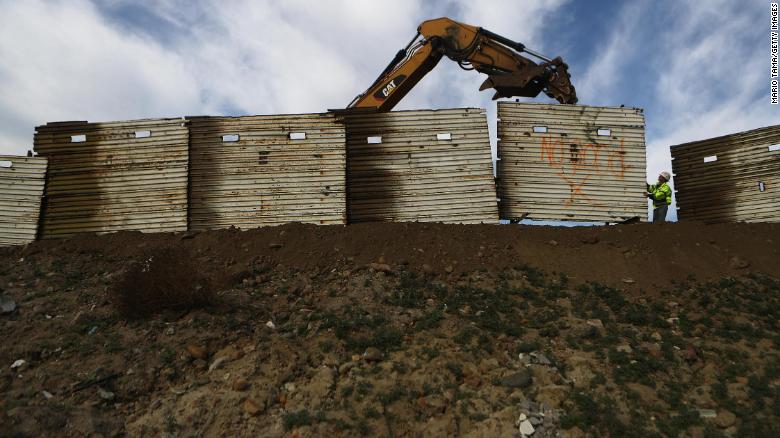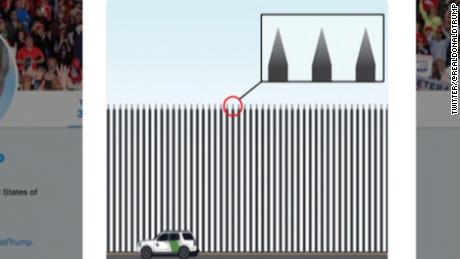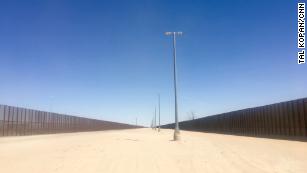This is how much of the border wall has been built so far
(CNN)Nearly two years into Donald Trump's presidency, the border wall that was a signature promise of his campaign hasn't been built.
And even if he gets all the money he wants from Congress this year, the wall won't be anywhere near finished.
Contractors have replaced miles of dilapidated fencing with more modern alternatives, but they haven't built barriers anywhere they didn't exist already.
That could soon change. Construction is scheduled to start in February on a project that will bring 14 miles of new border wall to the Rio Grande Valley.
Meanwhile, Trump and Congress are locked in a shutdown stalemate over funding for more wall construction. Officials say the $5.7 billion the administration is asking for would cover the cost of more than 200 miles of new and replacement wall.
But that would still leave most of the border without a wall.
Here's a look at what's already at the border, what construction is planned and what the Trump administration wants to build:
Man-made barriers cover only about a third of the border.
The US-Mexico border stretches for 1,954 miles. Currently, physical barriers cover 654 of those miles, according to US Customs and Border Protection.
What's known as vehicle fencing covers 280 miles. This is fencing that's low to the ground. It would stop a car, but people can easily step over it.
What's known as pedestrian fencing covers some 374 miles. This is taller and designed to block people from crossing on foot.
Some border fencing is made from helicopter landing mats.
There are several pedestrian fence designs in place at different points along the border.
Some areas contain layers of barriers, referred to as primary, secondary and sometimes tertiary fences. Currently about 37 miles of the border have secondary pedestrian barriers, according to CBP.
Much of the older fencing is made from repurposed Vietnam War-era helicopter landing mats. Newer fencing generally consists of 18- to 30-foot-tall steel bollards.

A construction crew works to replace an old section of the U.S.-Mexico border fence on January 11, 2019, as seen from Tijuana, Mexico.
Trump now says his 'big, beautiful wall' can be made of steel.
Yes, the President talked a lot about building a concrete wall on the campaign trail. But officials have said for a while that concrete is not the only option. When requesting bids for prototype designs back in March 2017, the focus was on making the wall "physically imposing."
In recent weeks, the President has expressed a greater interest in a barrier made of steel slats. It's not clear exactly what that means; some have pointed out it sounds a lot like the steel bollard fencing that's already in place at some points along the border -- which experts have long said would be the better option.
The wall prototypes have gone by the wayside.
As you might recall, construction firms built eight wall prototypes at the border -- four designed to be 30-foot concrete walls, four made of other materials -- that were then subjected to testing.
Some reports have suggested they didn't do that well in tests conducted by breaching experts, though the results haven't been made public.
Customs and Border Protection officials have sidestepped questions about what exactly the tests revealed. But they've said they were helpful in informing plans for new and replacement fencing that's currently being installed.

PHOTOS: Prototypes for border wall construction
This $365,000 prototype was built by Fisher Sand & Gravel of Tempe, Arizona. Customs and Border Protection is evaluating eight potential barriers in San Diego and may use characteristics of them in future construction along the border.
Hide Caption
5 of 8

PHOTOS: Prototypes for border wall construction
This $486,411 prototype was built by KWR Construction of Sierra Vista, Arizona. Customs and Border Protection is evaluating eight potential barriers in San Diego and may use characteristics of them in future construction along the border.
Hide Caption
6 of 8

PHOTOS: Prototypes for border wall construction
This $406,319 prototype was built by ELTA North America of Annapolis Junction, Maryland. Customs and Border Protection is evaluating eight potential barriers in San Diego and may use characteristics of them in future construction along the border.
Hide Caption
7 of 8

PHOTOS: Prototypes for border wall construction
This $470,000 prototype was built by Texas Sterling Construction Co. of Houston, Texas. Customs and Border Protection is evaluating eight potential barriers in San Diego and may use characteristics of them in future construction along the border.
Hide Caption
8 of 8

PHOTOS: Prototypes for border wall construction
This $344,000 prototype was built by Caddell Construction Co. of Montgomery, Alabama. Customs and Border Protection is evaluating eight potential barriers in San Diego and may use characteristics of them in future construction along the border.
Hide Caption
1 of 8

PHOTOS: Prototypes for border wall construction
This $453,538 prototype was built by W.G. Yates & Sons of Philadelphia, Mississippi. Customs and Border Protection is evaluating eight potential barriers in San Diego and may use characteristics of them in future construction along the border.
Hide Caption
2 of 8

PHOTOS: Prototypes for border wall construction
This $458,103 prototype was built by W.G. Yates & Sons of Philadelphia, Mississippi. Customs and Border Protection is evaluating eight potential barriers in San Diego and may use characteristics of them in future construction along the border.
Hide Caption
3 of 8

PHOTOS: Prototypes for border wall construction
This $320,000 prototype was built by Caddell Construction Co. of Montgomery, Alabama. Customs and Border Protection is evaluating eight potential barriers in San Diego and may use characteristics of them in future construction along the border.
Hide Caption
4 of 8

PHOTOS: Prototypes for border wall construction
This $365,000 prototype was built by Fisher Sand & Gravel of Tempe, Arizona. Customs and Border Protection is evaluating eight potential barriers in San Diego and may use characteristics of them in future construction along the border.
Hide Caption
5 of 8

PHOTOS: Prototypes for border wall construction
This $486,411 prototype was built by KWR Construction of Sierra Vista, Arizona. Customs and Border Protection is evaluating eight potential barriers in San Diego and may use characteristics of them in future construction along the border.
Hide Caption
6 of 8

PHOTOS: Prototypes for border wall construction
This $406,319 prototype was built by ELTA North America of Annapolis Junction, Maryland. Customs and Border Protection is evaluating eight potential barriers in San Diego and may use characteristics of them in future construction along the border.
Hide Caption
7 of 8

PHOTOS: Prototypes for border wall construction
This $470,000 prototype was built by Texas Sterling Construction Co. of Houston, Texas. Customs and Border Protection is evaluating eight potential barriers in San Diego and may use characteristics of them in future construction along the border.
Hide Caption
8 of 8

PHOTOS: Prototypes for border wall construction
This $344,000 prototype was built by Caddell Construction Co. of Montgomery, Alabama. Customs and Border Protection is evaluating eight potential barriers in San Diego and may use characteristics of them in future construction along the border.
Hide Caption
1 of 8

PHOTOS: Prototypes for border wall construction
This $453,538 prototype was built by W.G. Yates & Sons of Philadelphia, Mississippi. Customs and Border Protection is evaluating eight potential barriers in San Diego and may use characteristics of them in future construction along the border.
Hide Caption
2 of 8

PHOTOS: Prototypes for border wall construction
This $458,103 prototype was built by W.G. Yates & Sons of Philadelphia, Mississippi. Customs and Border Protection is evaluating eight potential barriers in San Diego and may use characteristics of them in future construction along the border.
Hide Caption
3 of 8

PHOTOS: Prototypes for border wall construction
This $320,000 prototype was built by Caddell Construction Co. of Montgomery, Alabama. Customs and Border Protection is evaluating eight potential barriers in San Diego and may use characteristics of them in future construction along the border.
Hide Caption
4 of 8








The idea of border barriers didn't start with Trump.
It's true that Trump has placed the idea of a border wall front and center ever since he first set foot on the campaign trail, but the idea of building barriers along the US-Mexico border took root long before he took office.
Construction of the federally funded border fence as we know it began with a 14-mile stretch near San Diego. Construction started during George H.W. Bush's presidency and continued into Bill Clinton's first term. The Illegal Immigration Reform and Immigration Responsibility Act, which Clinton signed into law in 1996, authorized the fortification of that fencing.
And the Secure Fence Act, passed during President George W. Bush's administration, authorized the construction of hundreds of miles of additional fencing. Notably, that measure also passed with support from then-Sens. Barack Obama and Hillary Clinton.
Since 2007, CBP says it's spent about $2.3 billion on fencing and related infrastructure along the US-Mexico border.
Contractors are already working on hundreds of miles of construction.
A number of contracts have been awarded since Trump took office, funded by appropriations from Congress for the 2017 and 2018 fiscal years.
Among them: Nearly $300 million to build 40 miles of replacement structures in multiple locations. These consist of both pedestrian walls and vehicle barriers. As of December 21, 35 of those 40 miles had been completed, according to Andrew Meehan, CBP's assistant commissioner for public affairs.
Appropriations last year provided $1.375 billion in funding to build 82 miles of new and replacement barriers in multiple locations across the border, Meehan said. Of that funding, $700 million has gone to contracts for construction of new and replacement wall systems, he said, and another $300 million "is ready to award as soon as the government reopens." The rest of the money, Meehan said, "supports CBP project management to include real estate, environmental, legal and program management support and will be obligated over the duration of the projects."
Soon we're actually going to see a wall built in a new section of the border.
Yes, that's the plan. Construction is expected to begin in February on 14 new miles in the Rio Grande Valley.
Called a levee wall system, the project includes the construction of a reinforced concrete levee wall, 18-foot-tall steel bollards installed on top of the concrete wall, and vegetation removal along a 150-foot enforcement zone. The price tag: $312 million.
The administration wants $5.7 billion to pay for 234 miles of construction.
Officials say the construction starting in February is only part of the picture. Funding from fiscal year 2018, they say, also covers the cost of building 70 more miles of barriers -- about 57 miles of which is replacement fencing.
And if the Trump administration's proposal for $5.7 billion more for a border wall is approved, officials say they'll be able to build 234 miles of new and replacement barriers -- about 100 miles of which will cover parts of the border that didn't have a barrier before.
But given that a partial government shutdown over the wall is already in its fifth week, whether that work will happen -- and exactly what will happen next -- is anybody's guess.
CNN's Maegan Vazquez contributed to this report.
end quote from:
https://www.cnn.com/2019/01/19/politics/us-mexico-border-wall-numbers/index.html





















No comments:
Post a Comment